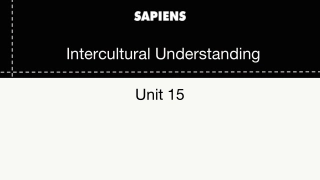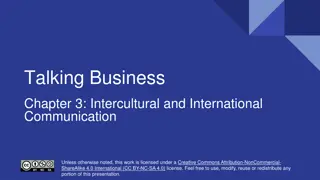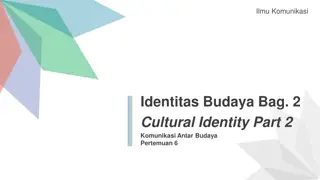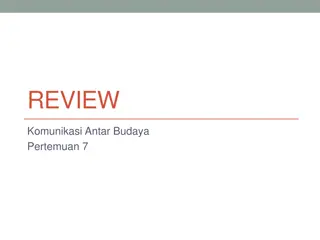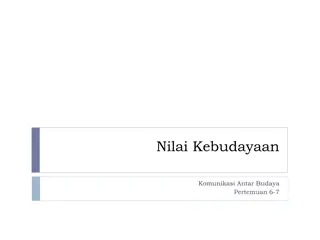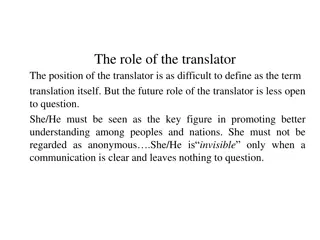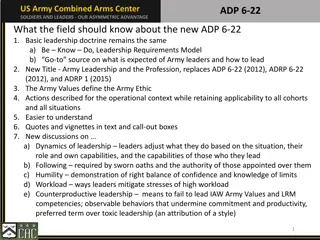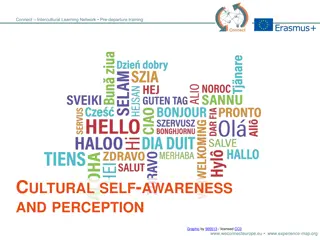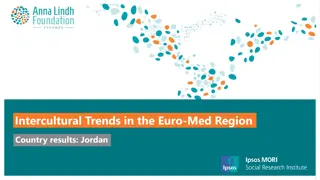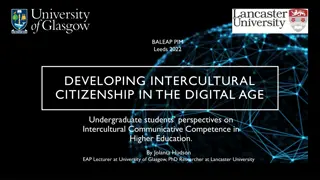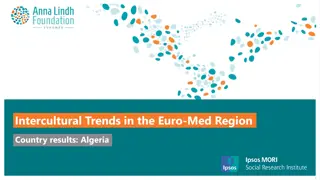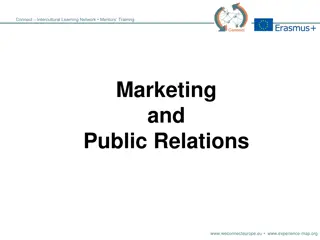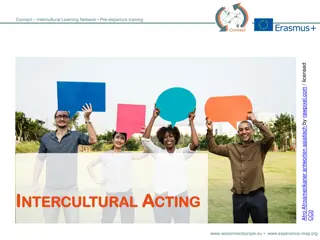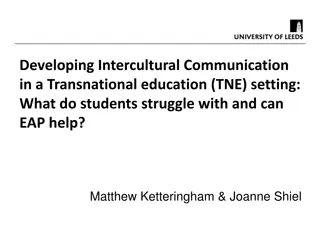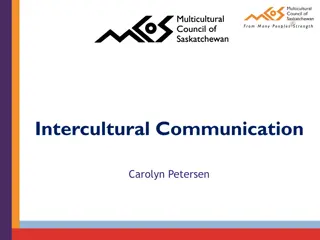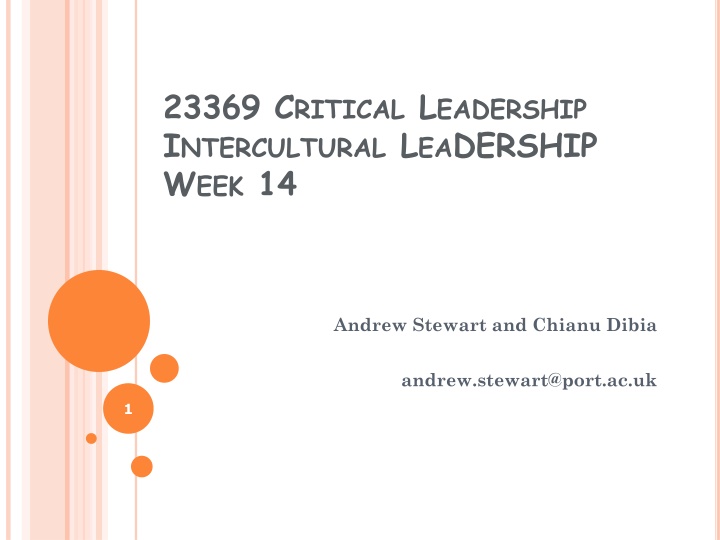
Intercultural Leadership: Insights and Discussions
Explore the nuances of intercultural leadership, delving into the differences in leadership across cultures. Discuss and analyze the impact of national cultures, rituals, and the concepts of power distance and collectivism. Gain a deeper understanding of how culture shapes leadership behaviors and practices.
Download Presentation

Please find below an Image/Link to download the presentation.
The content on the website is provided AS IS for your information and personal use only. It may not be sold, licensed, or shared on other websites without obtaining consent from the author. If you encounter any issues during the download, it is possible that the publisher has removed the file from their server.
You are allowed to download the files provided on this website for personal or commercial use, subject to the condition that they are used lawfully. All files are the property of their respective owners.
The content on the website is provided AS IS for your information and personal use only. It may not be sold, licensed, or shared on other websites without obtaining consent from the author.
E N D
Presentation Transcript
23369 CRITICAL LEADERSHIP INTERCULTURAL LEADERSHIP WEEK 14 Andrew Stewart and Chianu Dibia andrew.stewart@port.ac.uk 1
Objectives for this workshop: To understand the issues surrounding Intercultural leadership. Discuss and explore leading edge international research on leadership in a global context 2
Group Discussion: To what extent does leadership and therefore the characteristics of leaders differ by culture?
Culture defined customary and traditional way of thinking and doing things (Jaques 1952:251) configuration of norms, values, beliefs, ways of behaving and so on that characterize the manner in which groups and individuals combine to get things done (Eldridge and Crombie 1974:89) How things are done around here (Drennan 1992:3)
What is culture? The collective programming of the mind? Hofstede (1981)
Impact of National cultures Hofstetde`s dimensions of national culture (1984, 1985, 2001) Based on research in IBM Power-distance Individualism/collectivism Masculinity/femininity Uncertainty avoidance Long term/short term orientation There is no right or wrong
Power Distance Image result Power distance is a term that describes how people belonging to a specific culture view power relationships - superior/subordinate relationships - between people, including the degree that people not in power accept that power is spread unequally.
Collectivism in group The degree to which individuals show pride, loyalty and commitment in their work organisations or families
Performance orientation Degree to which members of a society or work organisation encourage or reward individuals for high performance
categorising societies along bipolar dimensions matched samples or experimental conditions external measurable features-so comparison between countries (but is this necessary?) Is this stereotyping? Where do we draw boundaries? Scotland, England, Wales, Northern Ireland? Northern and Southern Ireland? Cornwall, The North East? To what extent do organisational cultures supersede national cultures? (See: Gerhart, 2008) comparison
Project GLOBE The largest ever cross-cultural study on leadership Project GLOBE (ongoing from 1993): a major multi-phase project by House et al. Focuses on Relationship between national/societal culture, organisational culture and leadership effectiveness
Project GLOBE objectives identify any universally accepted leader behaviour, attributes and organisational practices or are there some that are effective in some cultures only? locate cultures along 10 dimensions (clusters)
Scope of Project 17,000 participants 950 work organisations 62 societies/cultures Long-term, Ongoing project
G.L.O.B.E. definition of leadership the ability of an individual to influence, motivate and enable others to contribute toward the effectiveness and success of the organizations of which they are members 16
GLOBEs clusters (see French (2015) page 151 for breakdown of countries) Anglo cultures Latin Europe Nordic Europe Germanic Europe Eastern Europe Latin America Sub-Saharan Africa Arab cultures Southern Asia Confucian Asia
Identification of leadership styles Charismatic/value based Self protective Autonomous Humane Participative Team oriented
Assertiveness The degree to which individuals are assertive, confrontational or aggressive in their relationships with others in a particular cultural setting
Humane The degree to which members of a society elicit, encourage or reward individuals for their fairness, altruism or generosity to others
Attributes Universal attributes showing good leadership include charisma, team oriented Cultural variations e.g. autonomous, self protective, participative, humane (cited in Browaeys 2011)
A few findings Anglo cluster. How should things be? Low score for Power Distance. High on Collectivism Within individualistic, democratic societies, participative leadership and delegation important
Southern Asiahow things should be high on all dimensions except performance orientation gender egalitarianism Power Distance wish to see humane, patriarchal, team- oriented leadership (Ashkanasy 2002)
Some specific findings too e.g. The Netherlands place emphasis on egalitarianism and are sceptical about the value of leadership. Terms like leader and manager carry a stigma. If a father is employed as a manager Dutch children will not admit this to their school mates.
Arabs, Iranians, Malaysians Arabs worship their leaders - as long as they are in power Iranians seek power and strength in their leaders Malaysians expect their leaders to behave in manner that is humble, modest and dignified 25
Universal Attributes (Browaeys 2011) Reflect good leadership Impede good leadership Integrity Charisma Team oriented Orientation towards excellence Decisiveness Intelligence Irritable Egocentric Loner Non explicit Asocial Dictatorial Ruthless Un co-operative
Group Discussion: How trainable are these good attributes ? Integrity Charisma Team oriented Orientation towards excellence Decisiveness Intelligence
Some criticisms of Project Globe Too much on management Restricted sector Limited age range Different understanding of terminology Does not consider subcultures (China, India, the US) Dynamic process of culture Issues Untranslatability of leadership Universal theorisation of leadership The relative value
GLOBE underlying theory Cultural values and practices affect what leaders do Leadership affects organisational form, culture and practices Societal values and practices impact at the organisational level Organisational contingencies e.g. size, technology Relationships between contingencies and practices moderated by cultural forces Leader effectiveness from acceptance 29
Reading and references Ashkanasy, N (2002) in International Journal of Organisational Behaviour 5 (3) Branine, M (2011) Managing across Cultures London:Sage Browaeys, M., Price, R. (2011) Understanding Cross Cultural Management French, R. (2015) Chapter 7. Guirdham (2005) pages 304-316 House, R. Javidan,M. & Dorfman,P, (2001) (2002) see Victory McKenna,S. (1998) in Leadership and Organisation Development Journal 19 (2) pages 106-112. Schneider & Barsoux (2003) pages 106-114 http://www.sciencedirect.com/science/article/pii/S109095160100069 4 30

